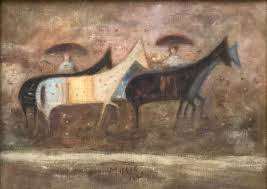
©
У 2025 році прикордонні міста Ново-Горица (Словенія) та Горіція (Італія), які вперше спільно обіймають титул Європейської столиці культури, вшановують Зорана Мушича (1909–2005) — видатного словенського художника та графіка. Серія виставок, присвячених його творчості, відбудеться в обох країнах, підкреслюючи культурну спадщину митця. Мушич народився в селі Буковиця поблизу кордону, а після Другої світової війни жив між Венецією та Парижем. У 1944 році він був ув'язнений у концтаборі Дахау, що глибоко вплинуло на його творчість. Цей досвід відображено в серії "Ми не останні", створеній у 1970-х роках. Художник черпав натхнення з рідного регіону Крас, створюючи пейзажі, портрети, зображення тварин та види Венеції. Перша виставка відкриється 25 квітня в галереї замку Штаньєль, де роботи Мушича будуть представлені поряд із творами Лойзе Шпацала. Друга експозиція стартує 14 травня в замку Доброво. Наймасштабніша ретроспектива відкриється 25 травня в палаці Аттемс-Петценштайн у Горіції та триватиме до 31 жовтня. Серед експонатів — унікальна "Цюрихська кімната", створена Мушичем у 1940-х роках, яку спеціально перевезуть зі Швейцарії. Словенські виставки діятимуть до початку вересня. У 1980-х роках художник передав Новій Гориці понад 130 графічних аркушів, частину яких покажуть у Штаньєлі та Доброво до січня 2026 року. Мистецтвознавці наголошують: "Його роботи — це не лише образи, а свідчення страждань. Мушич створив особливу мову, де фігура і пейзаж стають єдиним — він сам казав: 'Коли я кажу пейзаж — я думаю про тіла. Про пейзажі з тіл.'" Твори Зорана Мушича зберігаються в приватних і публічних колекціях по всьому світу. У Словенії їх можна побачити в Національній галереї в Любляні, куди родичі художника передали значну частину спадщини понад десять років тому.
Slovenia and Italy honour painter Zoran Mušič
In 2025, the border cities of Nova Gorica (Slovenia) and Gorizia (Italy), jointly holding the title of European Capital of Culture for the first time, are paying tribute to Zoran Mušič (1909–2005) — a prominent Slovenian painter and printmaker. A series of exhibitions dedicated to his work will take place in both countries, highlighting the artist’s cultural legacy. Mušič was born in the village of Bukovica near the border and lived between Venice and Paris after the Second World War. In 1944, he was imprisoned in the Dachau concentration camp — a traumatic experience that profoundly influenced his art. This is reflected in his series We Are Not the Last, created in the 1970s. The artist often drew inspiration from his native Karst region, producing landscapes, portraits, depictions of animals, and views of Venice. The first exhibition will open on 25 April at the Štanjel Castle gallery, where Mušič’s works will be presented alongside those of Lojze Spacal. The second exhibition is set to begin on 14 May at Dobrovo Castle. The most comprehensive retrospective will open on 25 May at the Attems-Petzenstein Palace in Gorizia and will run until 31 October. Among the exhibits is the unique Zurich Room, created by Mušič in the 1940s, which will be specially transported from Switzerland for the occasion. The exhibitions in Slovenia will remain open until early September. In the 1980s, the artist donated more than 130 prints to Nova Gorica, a portion of which will be displayed in Štanjel and Dobrovo until January 2026. Art historians emphasize: “His works are not just images — they are testimonies of suffering. Mušič created a distinctive visual language where figure and landscape merge — he once said: ‘When I say landscape, I think of bodies. Landscapes with bodies.’” Zoran Mušič’s artworks are held in both private and public collections around the world. In Slovenia, his legacy can be viewed at the National Gallery in Ljubljana, which received a substantial donation from the artist’s family over a decade ago.

©
1159